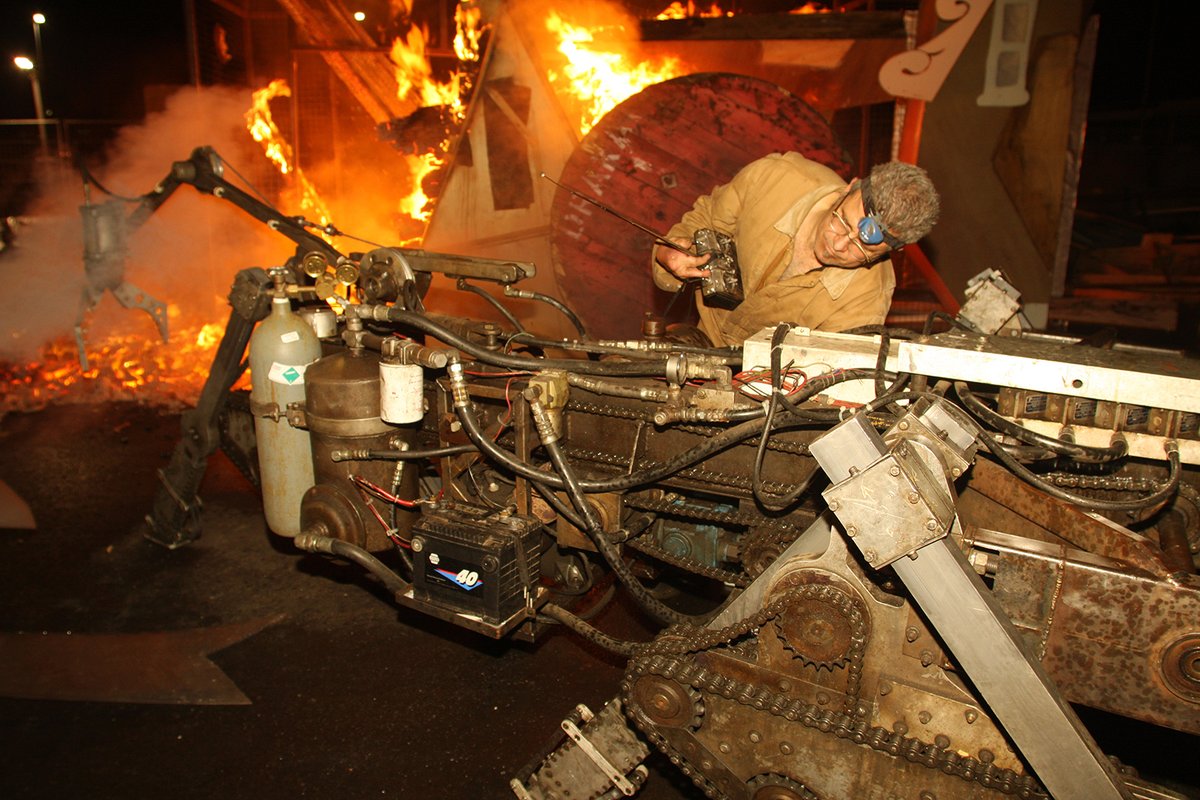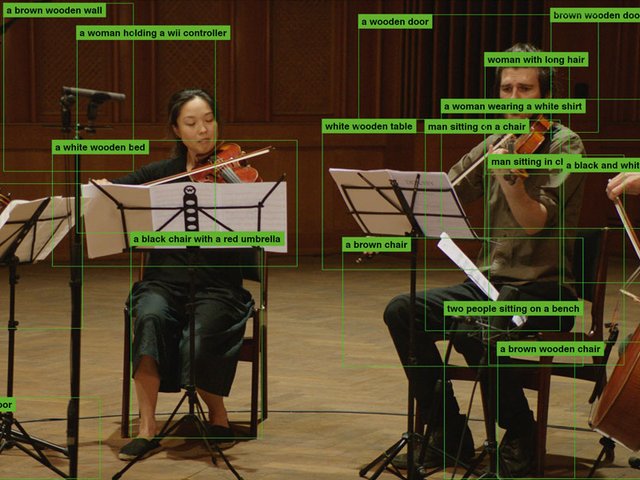For four decades, Mark Pauline has turned robotics into a performance art. In 1978, the Bay Area artist started Survival Research Laboratories (SRL), a collaborative project with the stated purpose of “re-directing the techniques, tools, and tenets of industry, science, and the military away from their typical manifestations in practicality, product or warfare”. Since then, Pauline and a team of “creative technicians” have been building an army of massive machines—the giant articulated Spine Robot that gingerly picks up objects with its mechanised arm, the dangerously powerful Pitching Machine that can hurl a 2 x 4 at 200mph, and of course Mr Satan, a blast furnace with a human face that shoots flames from its eyes and mouth. These are used in performances that inspire equal parts awe, excitement and fear. Pauline and the SRL team are in New York this week for their first major gallery show at Marlborough Contemporary, Fantasies of Negative Acceleration Characterized by Sacrifices of a Non-Consensual Nature, opening on Saturday 6 January, with performances starting at 4pm. We spoke to the artist from his studio in Petaluma.
The Art Newspaper: These machines are meant to have their own life, they’re independent actors in a way?
Mark Pauline: Actually, they’re just meant to replace human performers in the events that we stage. They’re good at that. I’ve been able to design shows and come up with ideas for machines that somehow people have accepted over the years as being capable of generating live performances, as opposed to them just being sculptures. So it’s too late for people to decide that’s not true. It’s been 40 years since we started SLR.
We’re going to be doing some fun stuff for the opening. I have always been fascinated with the whole right and left wing. With progressives, it’s more about an accelerated world where things change quickly, and the reactionaries are people who are trying to stop change. So it’s “negative acceleration”.
I thought it might be fun to physically represent that concept with SRL machines. There will basically be the Pitching Machine shooting boards into a box that’s heavily armored and with very thick bulletproof glass. It will be sacrificing small robots and obliterating them.
As an artist, it’s more exciting to think of yourself working in a super right-wing dictatorship where you can’t say anything directly and everything has to be implied. Like in the old Soviet Union. I decided to pretend it’s really dangerous—I mean, at least it’s not yet. We are still in a place where you don’t have to worry about that [in the US]. I think it’s more fun to make implicit statements. So the theme of the show is in keeping with that. I’m not out there saying anything direct, but I think the message is clear that I am on the side of acceleration.
There is a certain point where you can’t really get in the way of progress, can you? You’re either going to join or be left behind.
You can get in the way in the sense of, you can stand in front of the train. Something will happen, but will that be what you intended?
The subtitle of the show is “characterized by sacrifices of a nonconsensual nature”. I always try to make the titles for the shows real artsy, but also representative of a public consciousness, what people are thinking about. It seems like people are thinking a lot about nonconsensual things and about a fear of going backwards. So in the show, we are able to physically represent these ideas in a very emphatic format, because we have all of this equipment.
The SLR performances are sort of a series of sight gags. This is a smaller production, but there will be some stuff happening out in the street in front of the gallery, which is another variation on the theme of sacrifice.
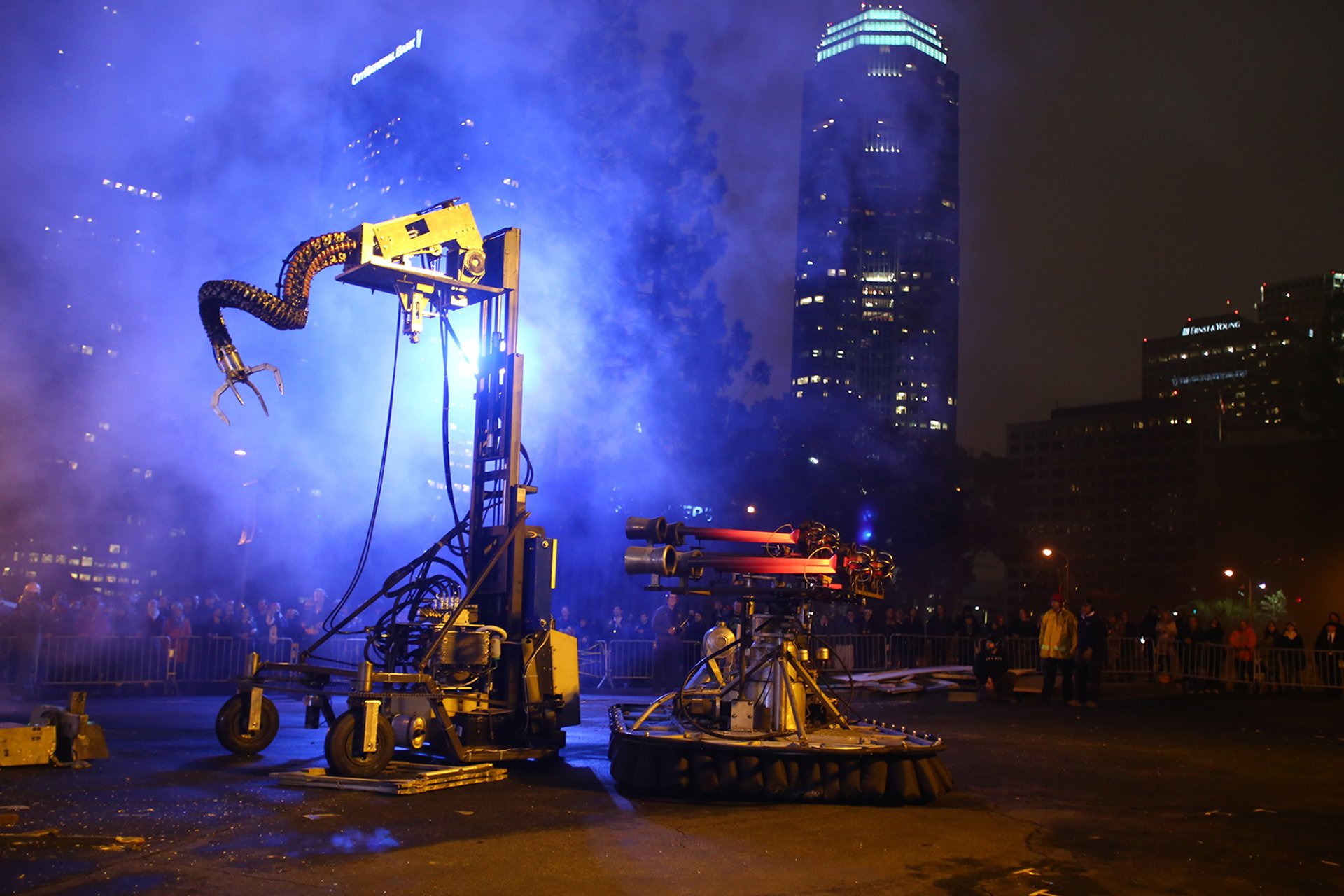
Spine Robot in a performance in San Francisco Courtesy of Survival Research Laboratories
Is it true that this the first time that these kinds of works are being presented in a gallery setting?
Well, it is basically true. We’ve shown little bits and pieces in San Francisco. But that was just for a couple of days. That wasn’t a five-week run at a major gallery. That was more of a pop-up kind of thing, and it was also connected with a performance in the city. This is on another level. Galleries where you might potentially be able to sell a piece of equipment or a piece of art like this, they don’t really exist in San Francisco. That’s probably why people like me and other artists have developed more ad hoc approaches to exhibiting their work.
Are you hoping that the machines will sell here in New York?
It’s a beautiful thought. I have 11,000 square feet of warehouse space, and it’s completely full of robots and machines that I’ve built here and that have been made here. So, yeah, I wouldn’t mind—I mean, just from a purely practical standpoint of space, because we essentially have a modern factory here, with all the computer-controlled equipment and design software, we can produce these things really quickly here—I would like to have more room, and I would like not to have to do any work other than this work.
SRL at XFF Teaser Reel #4b Survival Research Labs LA 2012 Genuine Survival Research Labs
What other work do you do?
I’ve always funded SRL myself, personally. I don’t have a trust fund or any other means of income other than working. So I’ve just figured out ways—I mean, the flows of capital are so extreme that even someone like me, who is an art weirdo, a marginal character, can get arbitrary amounts of money.
I ended up becoming a kind of go-to person in the Bay Area for companies that have excess assets, which means high tech companies are shutting down labs, and they need somebody who can come in and knows what all the equipment is and can purchase it and repair it and then put it back on the market and not scrap it.
That’s become a very popular way of doing business with your excess equipment, when you don’t need it anymore, but you want to get it off your books for one reason or another. Sometimes I just buy entire businesses. I’m the guy that, if you see me walking in the door of your company, you know basically it’s over.
You’re like a secondary market dealer, almost, for technology.
Yeah, kind of. The problem that those companies have when they tried to do that is that there is no one really—I call it the beige box syndrome—no one really knows what anything is except for the scientists who were using. But I have educated myself, and I’m pretty good with technology, and I have a good memory. I can read manuals. I think that’s the important thing these days if you’re doing anything technical, if you can read manuals and you can read scientific papers, you are pretty much good to go.
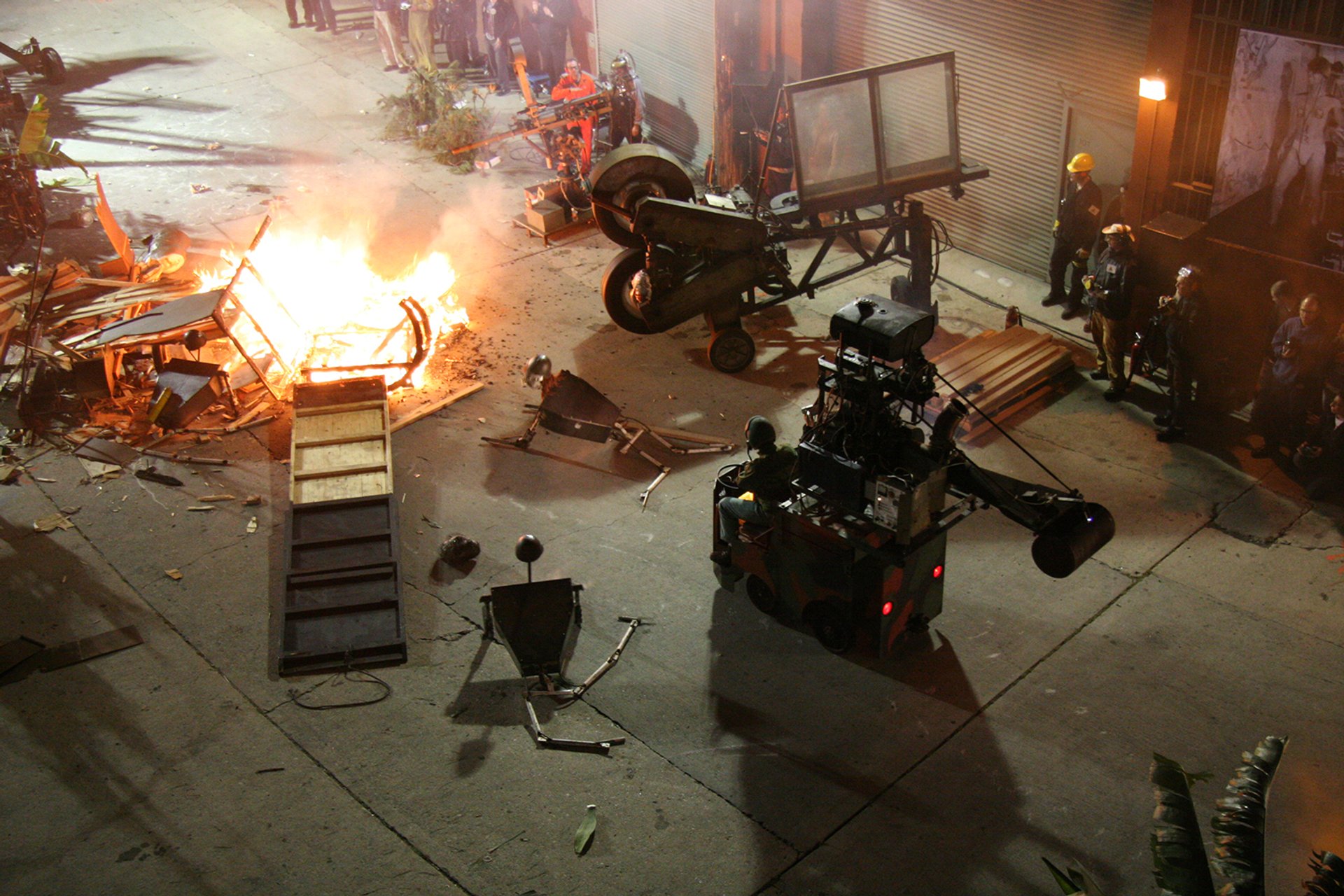
The Pitching Machine (1999) Courtesy of Survival Research Laboratories
What other projects are you working on now?
There is one particular machine that I will be working on after we install the show and come back to San Francisco. It’s based on technology that is used in a few of the modern fighter jets, like F35s. It’s a type of combustion device that we are employing in this very small but very powerful flamethrower. I read about these new fuel vaporising models that were used in the F35, and I said: “Well, I’ve got to get some of those.” They’re very hard to get, because they are regulated technology. You’re not allowed to buy it. It’s considered a weapon of mass destruction. You have to sign pages and pages of documents. The companies can’t actually sell them to you, they basically give them to you because they’re not for sale.
The concern is that I guess the Russians or the Chinese could use the technology to create more efficient Tiger jet engines or cruise missile engines. It’s very advanced fuel spray technology. I have an agreement with the company and the government that if someone came over here, I’d have to show them where all of the dozen nozzles that I have are. If I leave the country, I have to get a permit to leave the country with them. If I transfer ownership, I have to get a permit to transfer ownership, and that responsibility goes to the next person down the line.
The idea is to create a very hot and very large flame. The perfect flame does no work except create heat and light. The flame in your car engine is doing work. The idea here is to have a flame that does absolutely no work and is as hot as possible and very clean burning and very intense—it’s hot enough to melt steel. And that’s mounted on a very large industrial robot that can swing it around.
There’s a whole vignette that’s connected with that machine, where we have a large prop that is going to be incinerated by this flamethrower. We are going to do it underneath some of the monuments in San Francisco, like Coit Tower, at night, and I’m going to print out postcards. Since I moved here, I have always wanted to have art in those postcard stands that are all over San Francisco, like at Pier 39.
We will probably do one under the Golden gate Bridge, with the bridge in the background. That’s a long-standing goal of mine here at SRL, to do something that could be distributed as a postcard. I don’t know if the stores will accept them, but I bet they will.
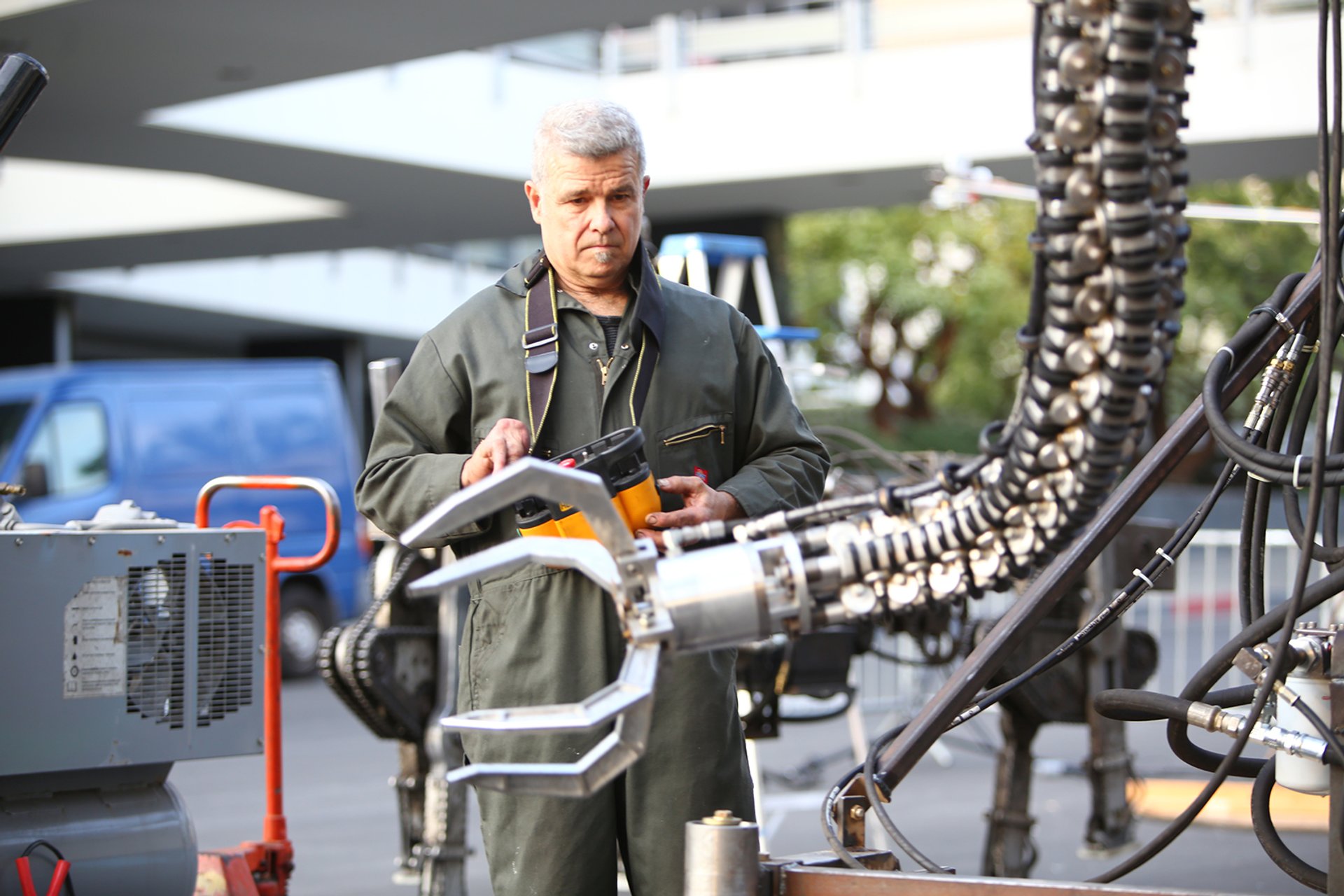
Mark Pauline with the Spine Robot (2014) Courtesy of Survival Research Laboratories
I have a bunch of other ideas—but I’m a firm believer in restraining creativity. Obviously there are people like Jeff Koons and most of those big-time artists. They get an idea and they build some little toy in a factory facility, and then they say, “I want some more of these carved out of gray granite, like 30 feet tall.” And that’s the last they think about it. Then they go off and spend the money that they make selling that stuff and just kind of come up with another toy or idea.
My feeling is that if you wrap up your work with all this technology, you actually have to know how to operate it. It puts the proper restraint on creative thinking. It’s not good to just sit there and think about all the things you’re going to do someday because you’re probably not going to get many of them done unless you’re a zillionaire. But I do have a whole string of future projects lined up. I mean, I probably have a dozen things that I have planned in the future, so I would like to make all of this things. It is easy to think up stuff. That’s not the problem.


